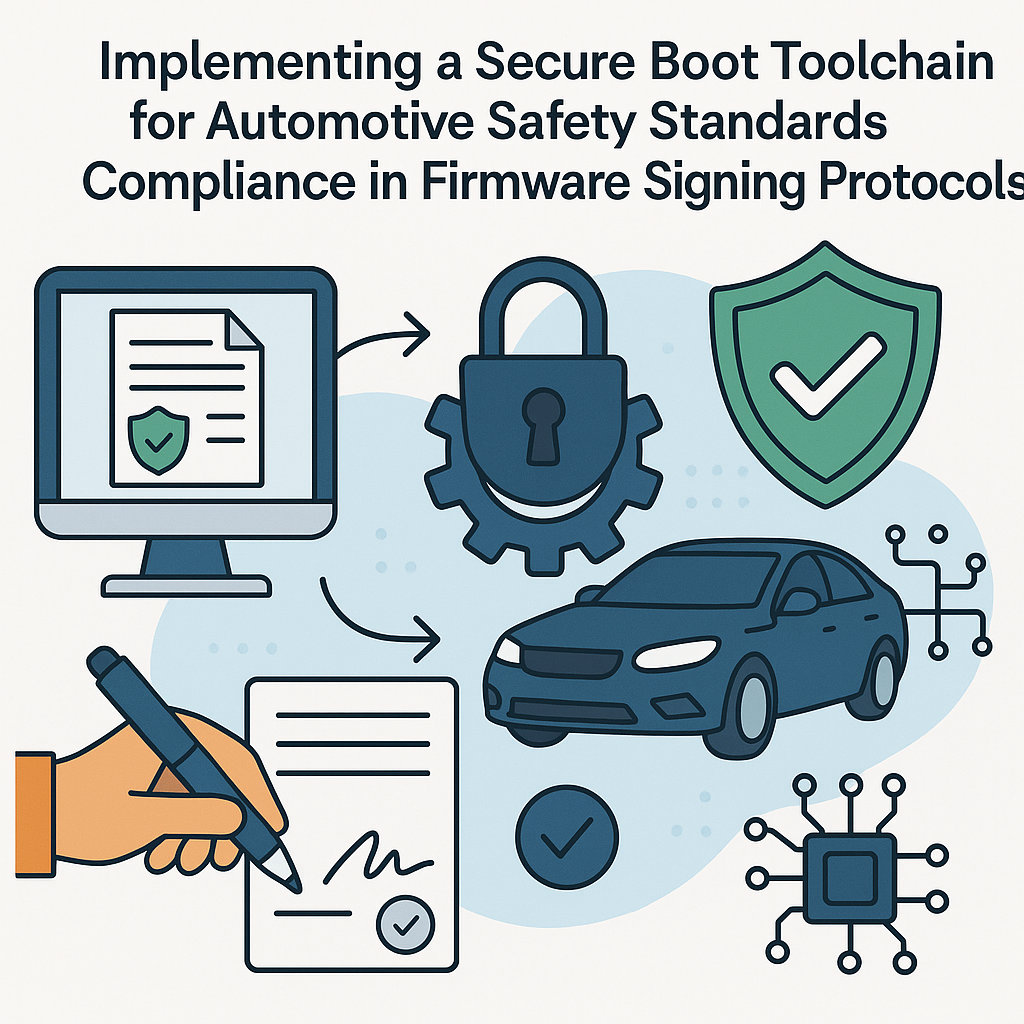Introduction
In the automotive industry, ensuring the safety and security of firmware is paramount, especially with the increasing integration of software in vehicles. Implementing a secure boot toolchain is a vital step toward compliance with automotive safety standards, particularly in firmware signing protocols. This blog post explores the importance of secure boot, the components of a secure boot toolchain, and best practices for achieving compliance.
Understanding Secure Boot
Secure boot is a security standard that ensures that a device only boots using software that is trusted and authorized. This is critical in the automotive sector where compromised firmware can lead to catastrophic failures and safety risks.
- Prevention of Unauthorized Access: Secure boot prevents unauthorized firmware from being executed during the boot process.
- Integrity Verification: It ensures that the firmware has not been tampered with by verifying cryptographic signatures.
- Compliance with Standards: Secure boot is crucial for meeting automotive safety standards such as ISO 26262 and ASPICE.
Components of a Secure Boot Toolchain
A comprehensive secure boot toolchain consists of several key components that work together to ensure the integrity and authenticity of firmware:
- Bootloader: The bootloader is responsible for initializing the hardware and loading the operating system or firmware securely.
- Cryptographic Keys: Secure storage and management of cryptographic keys are essential for signing and verifying firmware.
- Firmware Signing Tools: These tools are used to create digital signatures for firmware, ensuring its authenticity.
- Hardware Security Modules (HSM): HSMs provide a secure environment for key management and cryptographic operations.
- Secure Firmware Update Mechanisms: These ensure that firmware can be updated securely without compromising the integrity of the system.
Implementing a Secure Boot Toolchain
Implementing a secure boot toolchain involves several steps that must be carefully planned and executed:
- Define Security Requirements: Understand the specific security requirements based on the automotive standards applicable to your product.
- Select Appropriate Hardware: Choose hardware that supports secure boot features, such as TPM (Trusted Platform Module) or secure microcontrollers.
- Develop a Secure Bootloader: Create a bootloader that verifies firmware signatures before execution.
- Implement Cryptographic Techniques: Use robust cryptographic algorithms for signing and verifying firmware.
- Integrate Firmware Signing Tools: Ensure that your development process includes tools for signing firmware before deployment.
- Test and Validate: Conduct thorough testing to validate that the secure boot process works as intended and meets compliance standards.
Best Practices for Firmware Signing Protocols
To enhance the security of firmware signing protocols, consider the following best practices:
- Use Strong Cryptographic Algorithms: Ensure that your signing algorithms are up-to-date and resistant to current attack vectors.
- Implement Key Rotation: Regularly update cryptographic keys to minimize the risk of key compromise.
- Secure Key Storage: Store keys in a secure location, such as an HSM, to prevent unauthorized access.
- Audit and Monitor: Regularly audit your signing process and monitor for any anomalies that could indicate a security breach.
- Follow Standard Compliance: Stay updated on automotive safety standards and ensure that your processes align with these requirements.
Challenges in Implementing Secure Boot
While implementing a secure boot toolchain is crucial, it comes with its challenges:
- Complexity of Implementation: Integrating secure boot features into existing systems can be complex and may require significant changes.
- Performance Overhead: The additional security measures may introduce latency in the boot process.
- Cost Implications: Upgrading hardware and implementing secure solutions can lead to increased costs.
- Compliance Maintenance: Continuously maintaining compliance with evolving standards can be challenging.
Conclusion
Implementing a secure boot toolchain is essential for ensuring the safety and security of firmware in the automotive industry. By understanding the components involved, following best practices, and addressing challenges head-on, organizations can achieve compliance with automotive safety standards and protect their systems from potential threats. As the automotive landscape continues to evolve, prioritizing secure boot mechanisms will be vital for the future of automotive safety.



